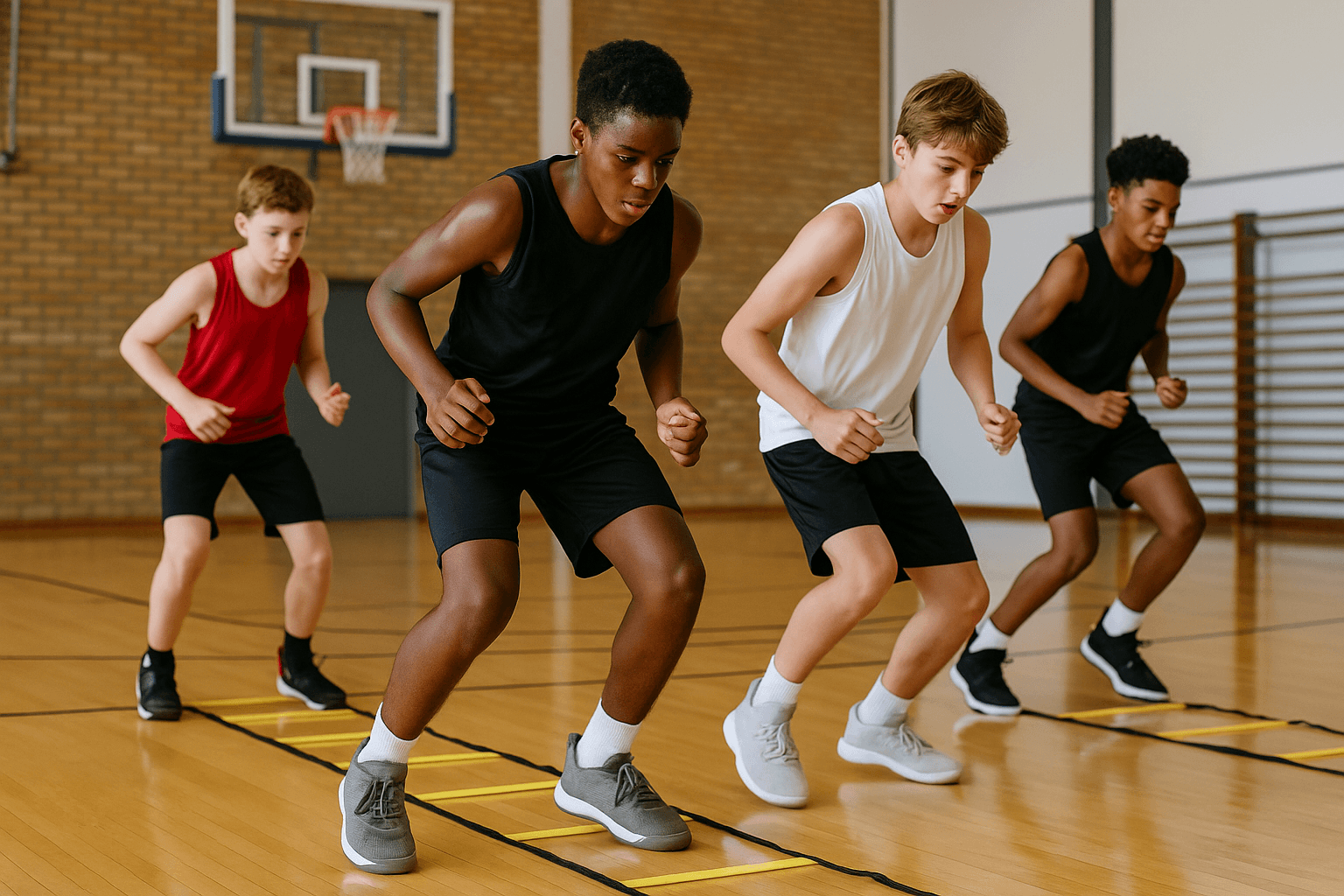
Agility and Quickness
Players practicing agility ladder drills to build foot speed, balance, and reaction time for basketball.
Basketball Agility and Quickness: How to Move Faster and Smarter
Basketball is a game of speed and reaction. Every play involves sudden changes—running forward, stopping quickly, cutting sideways, or reacting to what an opponent does. Agility and quickness are what allow players to keep up on defense, beat defenders off the dribble, and create open shots.
This guide will explain why agility matters, what movements are most important, and give step-by-step drills anyone can use to get faster and more balanced on the court.
Why Agility and Quickness Matter
In basketball, running fast is not enough. Players need to start, stop, and change direction instantly. A defender who can slide quickly will shut down drives. An offensive player with a fast first step will get to the basket before the defender can react.
Benefits of Agility Training
- Stronger defense – stay in front of your opponent instead of getting beat off the dribble.
- Better offense – a quicker first step helps you blow by defenders and score.
- Improved balance – sharp cuts and stops without falling off balance.
- Faster reactions – get to loose balls, rebounds, and steals before the other team.
Problems Without Agility
- Struggling to guard quicker players.
- Getting caught flat-footed when defending.
- Losing balance on drives or shot attempts.
- Being a step too slow to make winning plays.
Key Agility Movements in Basketball
Defensive Slides
A defensive slide is when a player moves sideways (laterally) to stay in front of their opponent. The player stays in a low stance, shuffling their feet like a fast crab walk, never crossing their legs.
- In-game example: A defender uses slides to cut off a driving guard and force them to pass the ball.
First Step Speed
The first step is the quick push-off when starting to move. A strong first step can make the difference between beating your defender to the rim or getting stopped.
- In-game example: A guard explodes past their defender right after catching the ball at the three-point line.
Quick Stops and Starts
The ability to go from a sprint to a stop, then restart again, without losing balance or control.
- In-game example: A player running full speed on a fast break stops suddenly to pull up for a jumper.
Change of Direction
Shifting side-to-side or cutting at sharp angles while staying in control.
- In-game example: A forward fakes left, cuts right, and creates space for an open layup.
Agility and Quickness Drills
Ladder Drills
A floor ladder (or tape/rope laid out in squares) is used to practice foot speed. Players step quickly through each square in different patterns.
- Examples: in-and-out steps, side shuffles, hopscotch jumps.
- Purpose: Builds fast feet, rhythm, and coordination.
Cone Drills
Cones are placed in different patterns, and players sprint, cut, or shuffle around them.
- Examples: zig-zag cone runs, T-drill, shuttle runs.
- Purpose: Teaches players how to cut sharply and stay balanced at game speed.
Closeout Drill
A closeout is when a defender sprints toward a shooter to contest their shot. In this drill, players sprint from a help position to the three-point line, then stop in a low stance with hands up.
- Purpose: Improves defensive quickness and balance when closing space.
Mirror Drill
Two players face each other. One moves side-to-side or forward and back, while the other copies (mirrors) the movement.
- Purpose: Builds reaction speed and sharp defensive movement.
Reaction Ball
A small, uneven rubber ball is dropped on the floor. Because it bounces unpredictably, players must react quickly to grab it.
- Purpose: Improves reflexes, reaction time, and hand-eye coordination.
Strength Work for Agility
Agility isn’t just about quick feet. Strong legs and core muscles make every movement faster and more controlled.
- Leg exercises: squats, lunges, calf raises for jumping and sprinting power.
- Core exercises: planks, Russian twists, sit-ups for balance and stability.
- Jump training (plyometrics): box jumps, jump squats for explosive movement.
Common Mistakes to Avoid
- Training too slow – always practice drills at game speed.
- Standing upright – staying too tall makes movements slower; stay low and balanced.
- Forgetting defense – agility isn’t just for offense; quick slides are key for stopping drives.
- Skipping strength work – weak legs and core mean slower, less controlled movement.
Final Takeaway
Agility and quickness are what separate good players from great ones. They allow you to defend faster players, attack defenders with speed, and make plays in pressure situations.
By practicing ladders, cones, closeouts, and reaction drills—along with strength and balance work—you’ll build the ability to stay one step ahead of your opponent. And in basketball, being one step quicker can be the difference between winning and losing.